Key takeaways:
- Interdisciplinary publishing merges diverse fields, fostering innovative solutions to complex problems, exemplified by collaborations between psychology and computer science, or biologists and sociologists.
- Challenges include differing terminologies and publication standards across disciplines, which can hinder collaboration and recognition in traditional academic landscapes.
- Effective collaboration requires clear communication, mutual respect, and shared goals to overcome barriers posed by disciplinary differences.
- Future trends include the rise of digital platforms, open access publishing, and the integration of artificial intelligence in interdisciplinary research, enhancing collaboration and democratizing access to knowledge.
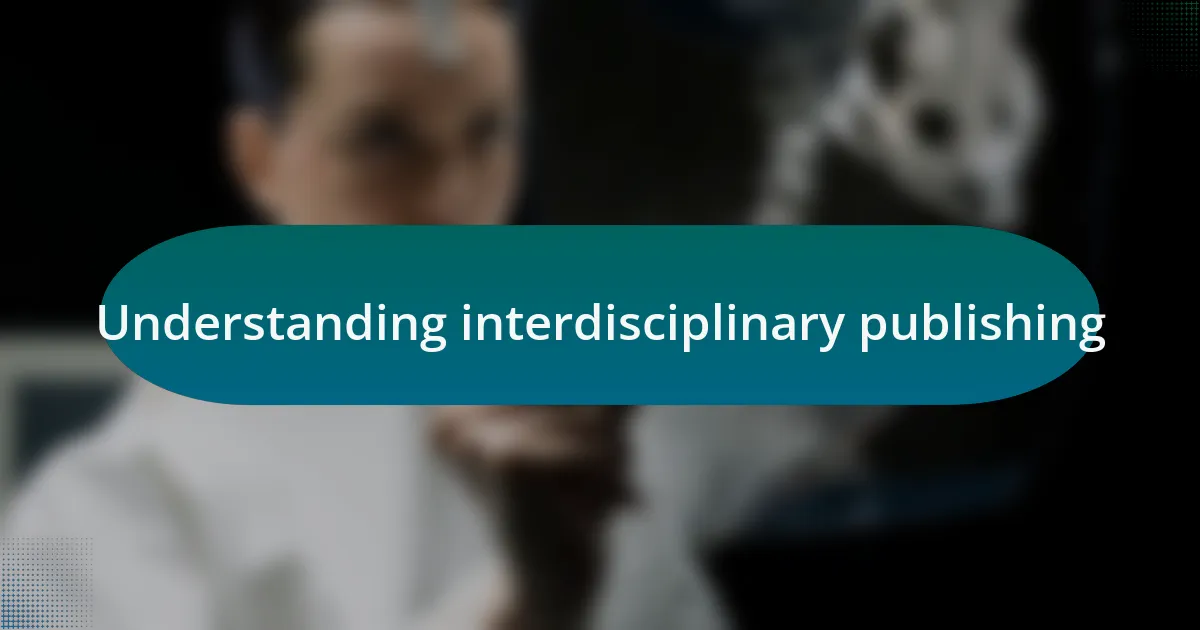
Understanding interdisciplinary publishing
Interdisciplinary publishing is an exciting arena where researchers from various fields contribute their unique perspectives to tackle complex problems. I remember when I first encountered a project that combined psychology and computer science; the blend of human behavior insights with technology created groundbreaking solutions. It opened my eyes to the profound impact that collaborative research can have—why limit ourselves to one discipline when the world’s issues are often multi-faceted?
When I think about interdisciplinary work, I often ask myself: how can one field truly understand a problem without the context provided by others? For instance, a study I read brought together biologists and sociologists to address climate change’s social implications. Their collaboration revealed that scientific data alone often fails to resonate with the public unless it’s framed within social narratives. This type of insight made me appreciate how vital interdisciplinary publishing is in transforming knowledge into action.
In my experience, the challenge often lies in finding common ground between disciplines. I once participated in a research project that required me to step outside my comfort zone and engage with experts in a different field. It was daunting but immensely rewarding, demonstrating that the creative friction between disciplines can lead to innovative ideas that a single perspective might miss. Understanding this dynamic just might be the key to unlocking the potential of future research.
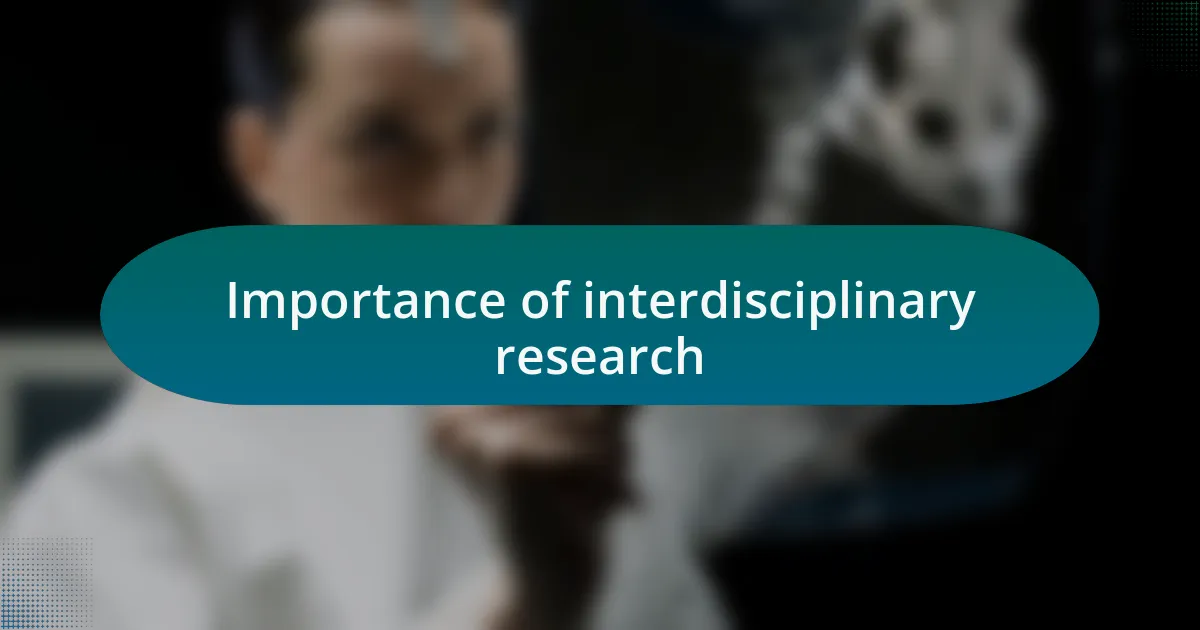
Importance of interdisciplinary research
Interdisciplinary research is vital because it allows us to tackle problems that are too complex for any single discipline to solve. I recall a fascinating conversation I had with a friend who works in environmental science. We discussed how integrating economics into environmental studies not only provided a clearer picture of environmental impact but also offered viable solutions for sustainable practices that local communities could embrace. This intersection of disciplines often reveals avenues of thought that I had never considered.
Moreover, it’s intriguing how interdisciplinary approaches can foster innovation. I remember attending a workshop where experts from engineering and public health collaborated to develop technologies for better disease monitoring. Their combined expertise led to a prototype that would have been impossible to create within the confines of just one field. Isn’t it amazing to think about how these collaborations can lead to groundbreaking solutions that can improve lives worldwide?
Finally, I believe that interdisciplinary research nurtures a culture of inquiry and curiosity. I once joined a brainstorming session that brought together artists and scientists to interactively explore the concept of perception. The dialogue sparked new ideas around the imagination’s role in scientific inquiry, shifting my understanding of how interdisciplinary work can not only drive progress but also invite a reflective look at our own biases and assumptions. Don’t you think that this kind of exploration is essential for making meaningful advancements?
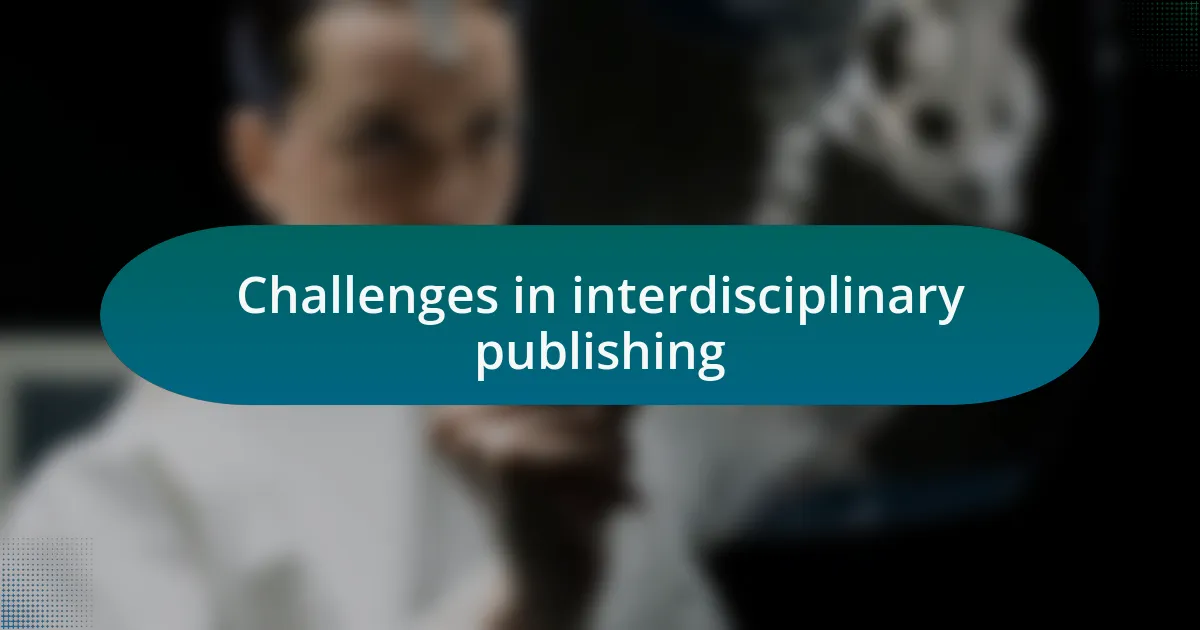
Challenges in interdisciplinary publishing
Navigating the complexities of interdisciplinary publishing can often feel like trying to cross a river without a bridge. One significant challenge I’ve encountered is the differing terminologies that each discipline brings to the table. For example, during a project involving both sociology and computer science, I found it quite frustrating when team members meant entirely different things by “data.” The lack of a shared language can lead to misunderstandings and hinder collaboration. How do we overcome this hurdle? It requires patience and open communication, two essential elements when bridging such diverse fields.
Another issue is the varying publication standards across disciplines. In my experience, the rigorous methods expected in scientific medicine often clash with the more exploratory nature of social sciences. I remember working on a paper that sought to combine findings from both areas, and it felt like we were constantly revising our approach to meet the demands of one discipline or the other. Isn’t it discouraging when a powerful idea gets bogged down by strict guidelines? This inconsistency can discourage researchers from pursuing interdisciplinary efforts altogether.
The struggle for recognition is perhaps the most daunting challenge of all. I have seen firsthand how interdisciplinary work sometimes gets overshadowed by more traditional research. Often, journals favor established disciplines, making it difficult to publish innovative work that draws from multiple fields. This dynamic can be disheartening, especially when you believe deeply in the potential of your collaborative findings. How can we advocate for these vital contributions? It starts with us, voicing the importance of interdisciplinary work and pushing for broader acceptance in the realm of academic publishing.
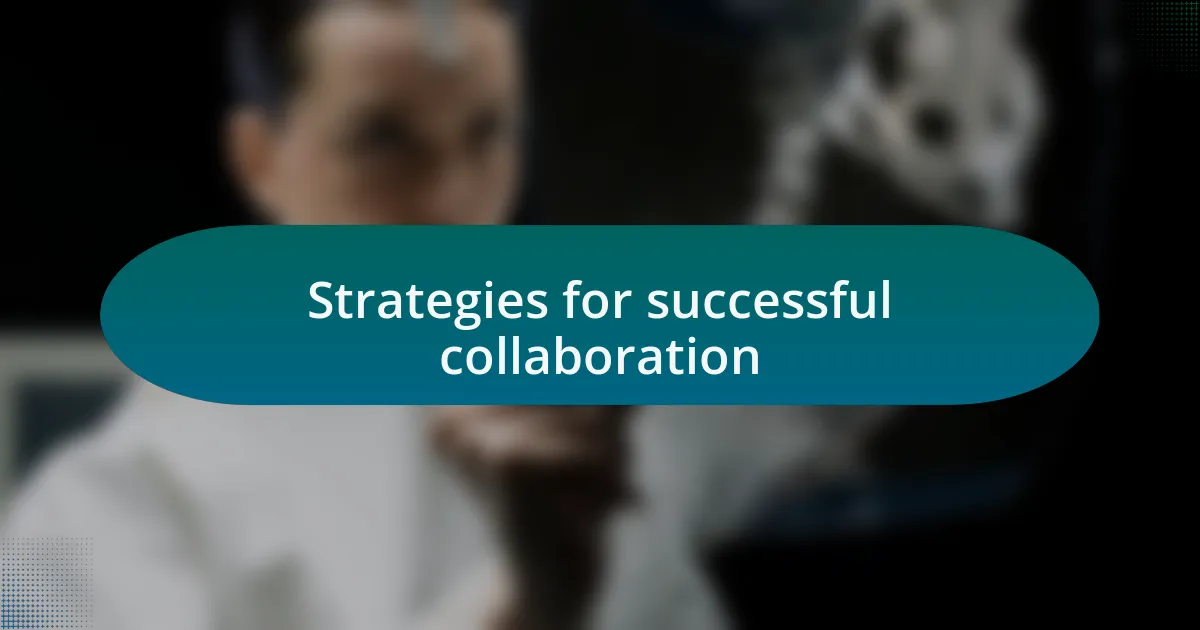
Strategies for successful collaboration
Effective collaboration hinges on establishing clear communication channels from the outset. I recall a project where my team used a shared digital platform to continuously update each other on progress, ideas, and feedback. This approach minimized confusion and made everyone feel included, helping to create a sense of belonging. Have you ever felt left out in a team discussion? I know that feeling all too well, and I can’t stress enough how transparency can alleviate those concerns.
Building mutual respect among team members is also crucial. In one project, our diverse backgrounds initially led to some friction, as we struggled to understand each other’s perspectives. However, by dedicating time to learn about one another’s fields, we cultivated a space where everyone’s expertise was valued. Isn’t it amazing how acknowledging differences can turn potential conflicts into powerful synergies?
Lastly, setting shared goals can greatly enhance teamwork. When my collaborators and I aligned our objectives, we transformed our project into a unified vision. I often reflect on how this shared focus helped us overcome the barriers of our individual disciplines. What do you think is more challenging: maintaining focus or navigating differing priorities? In my experience, having a common target to aim for can make all the difference.
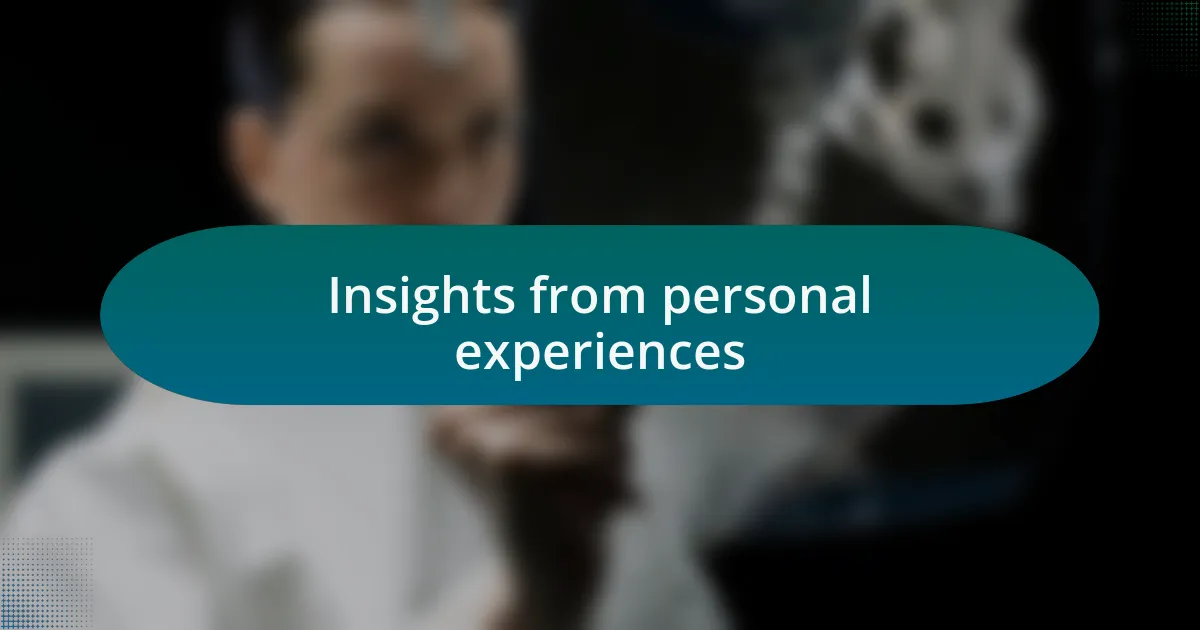
Insights from personal experiences
Through my journey in interdisciplinary publishing, I’ve encountered moments that deeply shaped my perspective. I remember working on a paper that combined insights from psychology and environmental science. The challenge wasn’t just blending the two fields; it was figuring out how to convey our shared findings in a way that resonated with both audiences. This experience taught me that clarity and simplicity in writing can bridge gaps between complex ideas. Have you faced a similar challenge in making complex concepts digestible for a diverse audience? It’s a rewarding process when you finally see your collaborative work spark interest across disciplines.
Another memorable experience involved a tight deadline for a joint publication. Stress levels ran high, and I found myself wondering if we could pull it off. However, the team’s camaraderie was remarkable. Instead of buckling under pressure, we harnessed our collective strengths and supported each other. It’s fascinating how adversity can foster collaboration—the bond we formed from that intense experience led to a publication that not only met the deadline but also exceeded our expectations. Have you experienced a moment when teamwork transformed stress into success?
I also reflect on how feedback panels shaped my understanding of interdisciplinary approaches. Participating in these discussions was eye-opening, as I realized many researchers grappled with explaining their work to those outside their fields. It sparked in me a commitment to crafting narratives that are not only informative but also engaging. When I see scholars from varying backgrounds struggle to connect, I often wonder what strategies could break down those barriers. In my view, developing a storytelling technique that reflects the essence of each discipline could create bridges, making interdisciplinary publishing not just effective, but truly impactful.
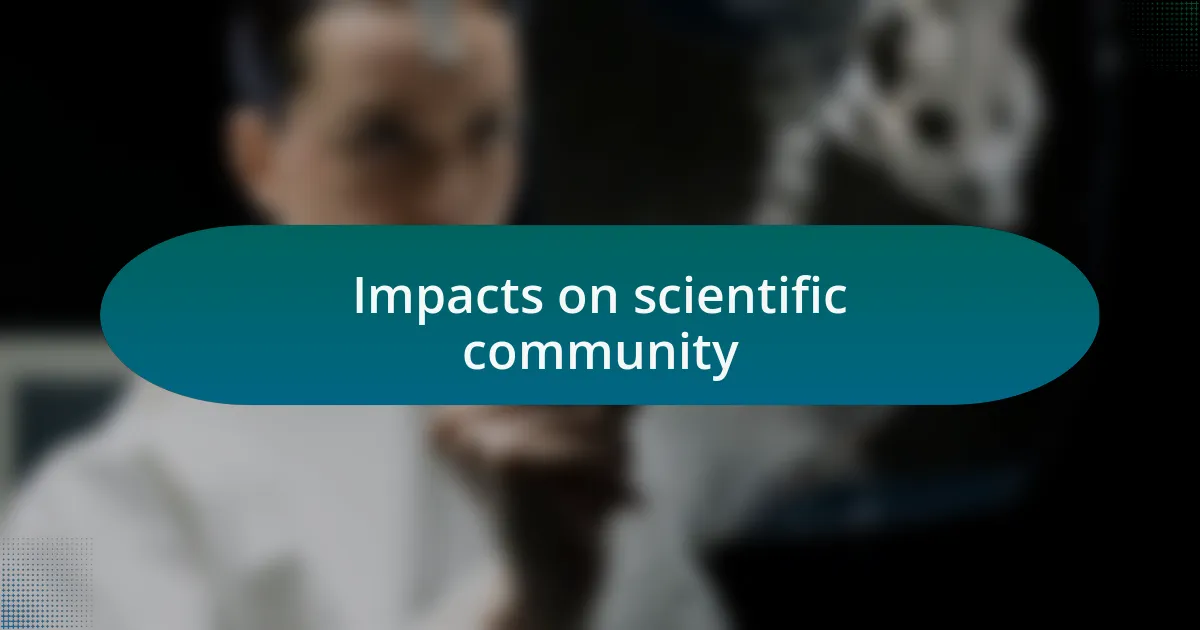
Impacts on scientific community
The impact of interdisciplinary publishing on the scientific community is profound. I recall a particularly enlightening conference where a physicist and a biologist co-presented their findings on biomimicry. Their synergy not only captivated the audience but also sparked a lively discussion that transcended their respective fields. It was thrilling to witness how ideas could collide and combine, leading to innovative solutions for real-world problems. Have you ever experienced that “aha” moment when two seemingly unrelated concepts meld into something extraordinary?
In another instance, I collaborated on a research project that addressed climate change by incorporating social science perspectives. This approach opened my eyes to the necessity of understanding human behavior for effective environmental strategies. I could feel the energy in the room as we debated the implications of our findings; it was clear that the fusion of disciplines invigorated our thinking. How often do we overlook the value of diverse expertise in tackling complex challenges?
Moreover, I find that interdisciplinary work encourages a culture of inclusivity within the scientific community. I remember participating in a peer-review process where scholars from various backgrounds brought unique insights to the table. This diversity not only enhances the quality of research but also fosters a sense of belonging among researchers. It’s exciting to consider, how might embracing interdisciplinary practices empower less-represented voices in science?
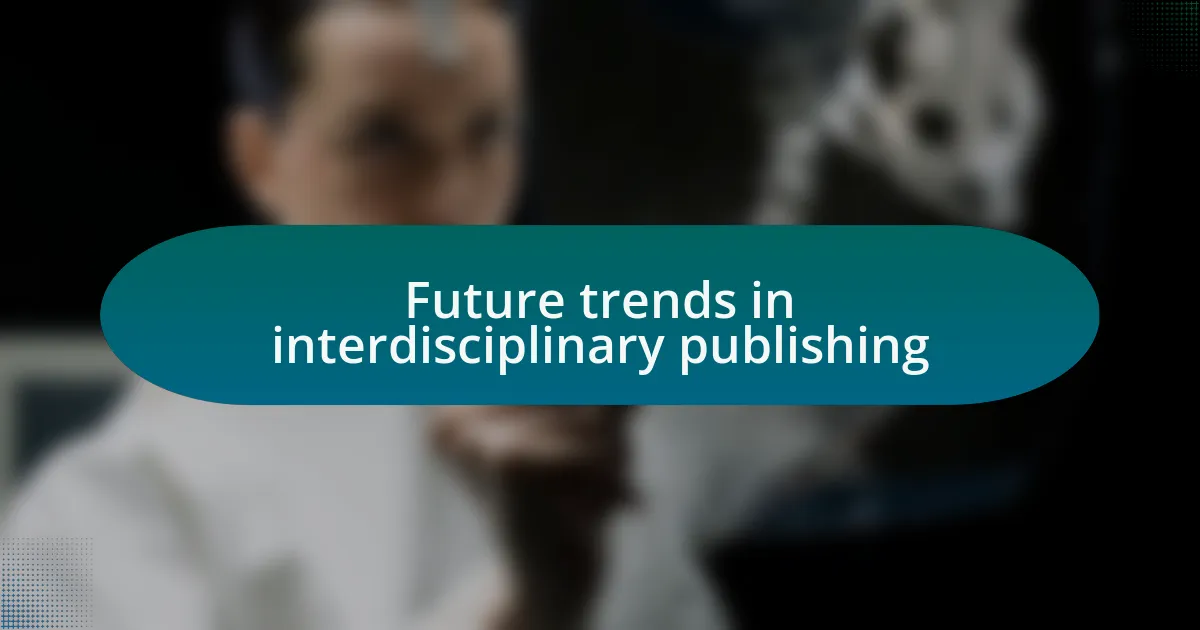
Future trends in interdisciplinary publishing
Looking ahead, I believe one of the most exciting trends in interdisciplinary publishing will be the increasing use of digital platforms to facilitate collaboration. During a recent online symposium, I experienced firsthand how virtual environments can break down geographical barriers, allowing experts from all over the globe to join forces. This shift not only expands the talent pool but also accelerates the pace of innovation, making me wonder: will our most groundbreaking discoveries emerge from the online exchanges of today?
Moreover, the rise of open access publishing is poised to redefine how we share knowledge across disciplines. I recall a moment when I downloaded a groundbreaking article for free, and it completely influenced my own research direction. This easy access democratizes information, allowing even those outside traditional academic circles to contribute. How much richer could our scientific discourse become if everyone had a seat at the table?
Finally, I’ve noticed a growing emphasis on integrating artificial intelligence and data analytics within interdisciplinary research. I once attended a workshop where we used machine learning tools to analyze complex datasets, blending expertise from computer science and biology. Watching how those insights unfolded was invigorating, leading me to think: could this be the key to unlocking the next generation of scientific breakthroughs?